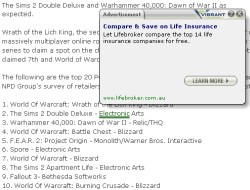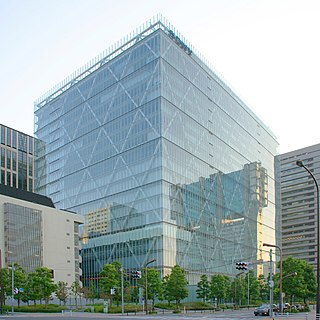Pop-up ads or pop-ups are forms of online advertising on the World Wide Web. A pop-up is a graphical user interface (GUI) display area, usually a small window, that suddenly appears in the foreground of the visual interface. The pop-up window containing an advertisement is usually generated by JavaScript that uses cross-site scripting (XSS), sometimes with a secondary payload that uses Adobe Flash. They can also be generated by other vulnerabilities/security holes in browser security.
Display advertising is advertising on websites or apps or social media through banners or other ad formats made of text, images, flash, video, and audio. The main purpose of display advertising is to deliver general advertisements and brand messages to site visitors.
Google AdSense is a program run by Google through which website publishers in the Google Network of content sites serve text, images, video, or interactive media advertisements that are targeted to the site content and audience. These advertisements are administered, sorted, and maintained by Google. They can generate revenue on either a per-click or per-impression basis. Google beta-tested a cost-per-action service, but discontinued it in October 2008 in favor of a DoubleClick offering. In Q1 2014, Google earned US $3.4 billion, or 22% of total revenue, through Google AdSense. AdSense is a participant in the AdChoices program, so AdSense ads typically include the triangle-shaped AdChoices icon. This program also operates on HTTP cookies. Over 11.1 million websites use AdSense.

Google Ads is an online advertising platform developed by Google, where advertisers pay to display brief advertisements, service offerings, product listings, video content, and generate mobile application installs within the Google ad network to web users.
Click fraud is a type of fraud that occurs on the Internet in pay-per-click (PPC) online advertising. In this type of advertising, the owners of websites that post the ads are paid an amount of money determined by how many visitors to the sites click on the ads. Fraud occurs when a person, automated script or computer program imitates a legitimate user of a web browser, clicking on such an ad without having an actual interest in the target of the ad's link. Click fraud is the subject of some controversy and increasing litigation due to the advertising networks being a key beneficiary of the fraud.
Pay-per-click (PPC), also known as cost per click (CPC), is an internet advertising model used to drive traffic to websites, in which an advertiser pays a publisher when the ad is clicked.
Ad serving describes the technology and service that places advertisements on Web sites. Ad serving technology companies provide software to Web sites and advertisers to serve ads, count them, choose the ads that will make the Web site or advertiser the most money, and monitor progress of different advertising campaigns. Ad servers are divided into two types—publisher ad servers and advertiser ad servers.
Ad blocking or ad filtering is a software capability for removing or altering online advertising in a web browser or an application. The most popular ad blocking tools are browser extensions. Other methods are also available.
An online advertising network or ad network is a company that connects advertisers to websites that want to host advertisements. The key function of an ad network is an aggregation of ad supply from publishers and matching it with advertiser's demand. The phrase "ad network" by itself is media-neutral in the sense that there can be a "Television Ad Network" or a "Print Ad Network", but is increasingly used to mean "online ad network" as the effect of aggregation of publisher ad space and sale to advertisers is most commonly seen in the online space. The fundamental difference between traditional media ad networks and online ad networks is that online ad networks use a central ad server to deliver advertisements to consumers, which enables targeting, tracking and reporting of impressions in ways not possible with analog media alternatives.
Online advertising, also called online marketing or Internet advertising or web advertising, is a form of marketing and advertising which uses the Internet to deliver promotional marketing messages to consumers. Many consumers find online advertising disruptive and have increasingly turned to ad blocking for a variety of reasons.
Search engine marketing (SEM) is a form of Internet marketing that involves the promotion of websites by increasing their visibility in search engine results pages (SERPs) primarily through paid advertising. SEM may incorporate search engine optimization (SEO), which adjusts or rewrites website content and site architecture to achieve a higher ranking in search engine results pages to enhance pay per click (PPC) listings.
Contextual advertising is a form of targeted advertising for advertisements appearing on websites or other media, such as content displayed in mobile browsers. The advertisements themselves are selected and served by automated systems based on the identity of the user and the content displayed.
In Internet marketing, search advertising is a method of placing online advertisements on web pages that show results from search engine queries. Through the same search-engine advertising services, ads can also be placed on Web pages with other published content.

Targeted advertising is a form of online advertising that is directed towards audiences with certain traits, based on the product or person the advertiser is promoting. These traits can either be demographic which are focused on race, economic status, sex, age, the level of education, income level and employment or they can be psychographic focused which are based on the consumer's values, personality, attitudes, opinions, lifestyles and interests. They can also be behavioral variables, such as browser history, purchase history, and other recent activity. Targeted advertising is focused on certain traits and the consumers who are likely to have a strong preference will receive the message instead of those who have no interest and whose preferences do not match a product's attribute. This eliminates wastage.

In-text advertising is a form of contextual advertising where specific keywords within the text of a web-page are matched with advertising and/or related information units.
Social network advertising, also social media targeting, is a group of terms that are used to describe forms of online advertising that focus on social networking services. One of the major benefits of this type of advertising is that advertisers can take advantage of the users' demographic information and target their ads appropriately.
Google Ad Manager is an online advertisement service brand introduced by Google in June 27, 2018. It consists of two former services, including DoubleClick for Publishers and DoubleClick Ad Exchange. It can be used as an ad server but it also provides a variety of features for managing the sales process of online ads using a publisher's dedicated sales team. Should a publisher not sell out all their available ad inventory, it can choose to run either other ad networks or AdSense ads as remnant inventory in Google Ad Manager.
In-image advertising is a form of contextual advertising where specific images on a website are matched with related advertisements.
140 Proof is an advertising company that uses social data from many sources to target relevant ads based on consumers' interests as indicated by their social activity across networks.









